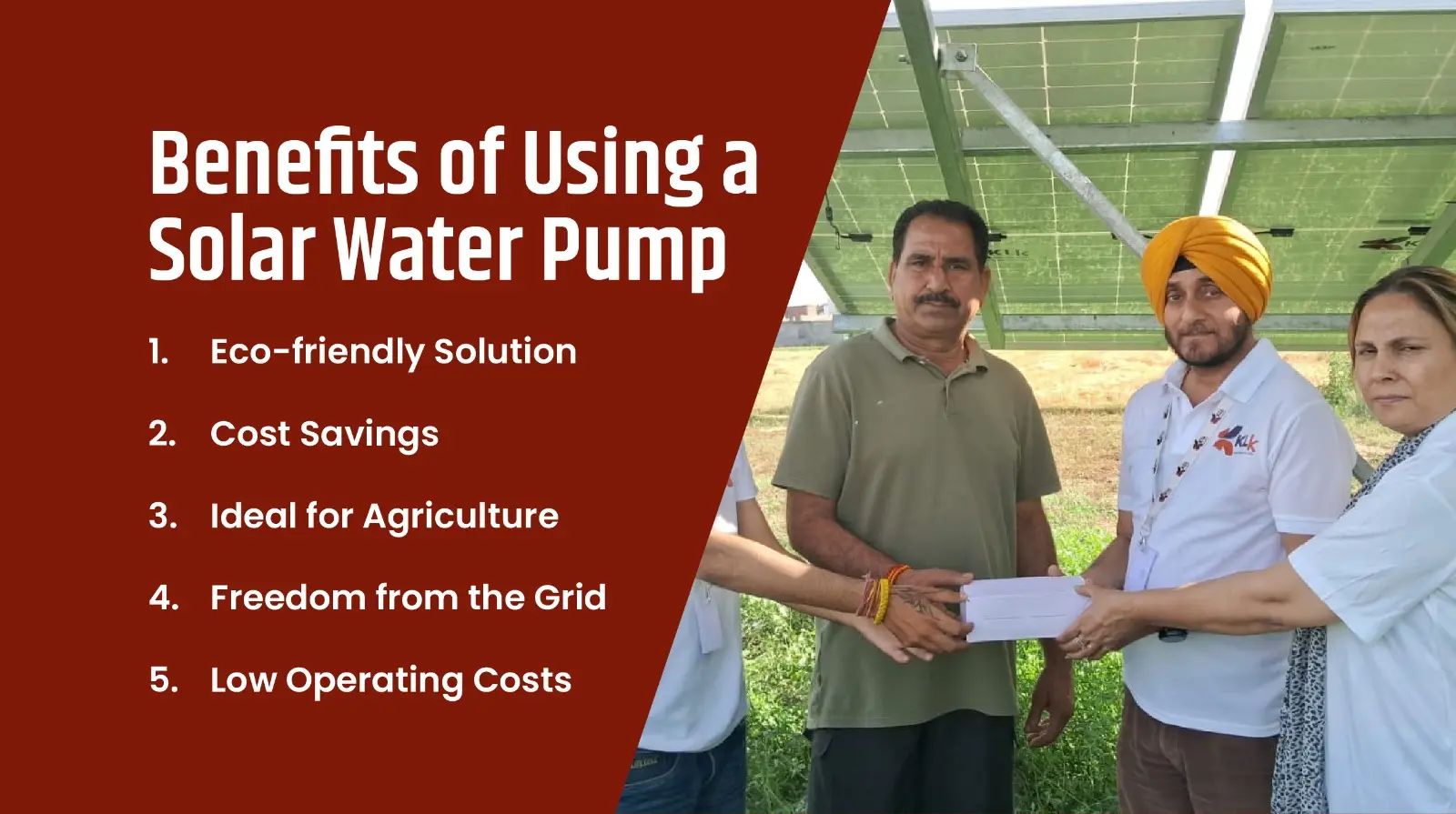What is a Solar Water Pump?
Solar water pumps are innovatively transforming the way we manage water needs, particularly in remote and rural areas. A solar water pump uses the abundant solar energy to generate power and fetch water from different sources. The perfect use of solar panels to generate electricity is what runs the solar pumps. This method of pumping water is a clean and green solution for all water needs.
In this blog, we’ll look into the different aspects of solar water pumps. Are you curious about how they work, all the amazing benefits they offer, the costs involved, and the available government subsidies? Read on.
How Do Solar Water Pumps Work?

A solar water pumping system is an interesting concept. A solar water pump uses the energy of the sun to fetch water and that is why it is sustainable.
Below is the detailed process of the working of a solar water pumping system:
1 Solar Panels Trap Sunlight
Photovoltaic panels that are placed in an area with maximum sun exposure absorb the sunlight. Through the photovoltaic effect, the solar cells convert it into electricity.
2. Controller Regulates Power Flow
Now that the electricity is generated, it’s sent to a controller. This controller is very useful because it regulates the power flow and makes sure the electricity is delivered in a steady manner to the pump. This makes sure everything works smoothly.
3. Inverter Converts DC to AC (If Necessary)
There are two types of pumps that function on current. If a pump is designed to work only on Alternating Current (AC), the DC electricity is sent to an inverter. The inverter converts it into Alternating Current electricity suitable for the pump’s motor.
4. Water Pumping
Now the most important function is put to work. The electrically driven pump extracts water from reservoirs, lakes and wells, among other sources.
5. Water Distribution
After drawing the water, the solar water pump delivers the water wherever it is needed. The solar water pumping system is also equipped with storage tanks. These are what help maintain a constant supply of water whenever needed, even when the sun’s not shining.
Their suspension from the power grid is what makes them an ideal choice for off-grid places. Solar water pumps save money on fuel and electricity and curb carbon emissions. Off-grid solutions such as solar pumps are what the world requires today amidst the energy crisis.
Benefits of Using a Solar Water Pump

The benefits that a solar water pump offers are many. Below are some of them.
- Eco-friendly Solution – The use of renewable energy makes them environmentally friendly. The use of such technology helps you move away from polluting sources like fuels or diesel.
- Cost Savings – There are not many expenses after the initial investment. Solar water pumps need very little maintenance. There will be a great reduction in the fuel costs and you’ll be able to save money in the long run.
- Ideal for Agriculture – There are many different uses of solar pumps for agricultural purposes. Using them makes it easy for farmers to irrigate their fields and supply water to livestock. Also the government subsidies on the installation of solar water pumps have benefited farmers immensely.
- Freedom from the Grid – There are numerous locations where electricity is not available. And without power, the world couldn't function. For water needs, a solar water pumping system comes forth as a boon. It reduces the reliance on grid electricity and other non-renewable sources.
- Low Operating Costs – A solar water pump has exceptionally low operating costs after it is installed. They turn into a cost-effective long-term solution with no extra costs.
Installation Process of a Solar Water Pump
There are several steps in the installation process of a solar water pump. Let's understand the process of installation in depth.
Step 1 - Analysing Water Requirements
It's important to survey the site before installation takes place to make sure the water demands are met. Finding the right pump size and capacity is one of the advantages of evaluating the water needs.
Step 2 - Selecting an appropriate solar water pump
Choosing the appropriate solar water pump comes next after determining your water requirements. There are different types of pumps on the market from which to choose. Pick the one that fits your requirements well for better efficiency. The options are -
- Submersible Solar Water Pumps
- Surface Solar Water Pumps
- DC Solar Water Pumps
- AC Solar Water Pumps
Step 3 - Installing the Solar Panels
Solar panels are what help run the solar pumps. These panels must be installed correctly to absorb sunlight properly. Select the right one from the different types of mounting structures for installing solar panels at an appropriate angle. These structures will ensure the panels get sunlight throughout the day.
Step 4 - Connecting the Pump
A controller is used to connect the water pump system once the panels are installed. This ensures that the pump receives the proper power flow to operate well. This involves connecting pipelines and wiring the system.
Step 5 - Testing the System
After this, power on your system and test the functioning. The test will confirm whether your solar water pumping system is working well or not.
Solar Water Pump Types
- Submersible Pumps - These pumps are intended for use in boreholes or wells. To extract water, these pumps are submerged in the deep-water source.
- Surface Pumps - These solar water pumps work on the surface level. They are less complicated and suitable for shallow water sources.
- DC Pumps - The electricity that is generated from the photovoltaic panels runs these pumps directly. This makes them efficient for places where low pressure is required.
- AC Pumps - These solar water pumps work on alternating current. Its system is equipped with an inverter to convert DC into AC. These are suitable for regions requiring a high flow rate.
You can refer to the guide: Different Types of Solar Water Pumps for more information.
Technical Specifications of a Solar Water Pump
Specification |
Details |
|
Power Rating |
1 HP, 2 HP, 3 HP, and above |
|
Solar Panel Capacity |
500W to 5000W |
|
Voltage |
12V, 24V, 48V, 72V |
|
Pump Type |
Submersible, Surface, DC, AC |
|
Flow Rate |
10 LPM to 300 LPM |
|
Head |
Up to 300 meters |
Cost of Installing a Solar Water Pump in India
Pump size, installation requirements, water head & discharge are the factors that impact the costs of installing a solar water pump. Depending on the application and system size, the cost of a solar water pumping system typically ranges between ₹50,000 to ₹5,00,000.
- System Size - The cost will be higher if you want to install large pumps for deep borewells or agriculture. For day-to-day use, small pumps are more fitting; therefore, the cost is a little less.
- Solar Panel Type - High-efficiency solar water pumps are more costly, but they offer better performance.
- Installation Charges - Contracting experts to install your solar water pump is going to be costly, but it will definitely be worth every penny.
We get your worries if you find the initial costs high, but there's an upside to the whole thing. A good solar water pumping system will function properly for years to come and will offer high performance.
Not only this, solar water pumps will help you save a lot on fuel and grid electricity charges, isn't that an amazing thing? For the initial investment, you're getting a great value for many years and also helping the environment.
Government Subsidies for Solar Water Pumps in India
Through a number of subsidies and incentives, the Indian government has been encouraging the use of solar water pumps. And that's a great thing. The farmers or rural people are getting the help they’ve desired for so many years at a greater level.
1. Pradhan Mantri Kisan Urja Suraksha evam Utthaan Mahabhiyan (PM KUSUM Scheme)
Under the PM KUSUM scheme farmers can now get subsidies for installing solar water pumps. The government of India even offered up to 80% subsidy for the installation! This is amazing, particularly if someone is considering installing solar water pumps for agricultural purposes.
This not only makes more and more individuals switch to solar but also reduces the expenses and makes the world a better place.
2. Subsidy for Solar Water Pumps by State Governments
Apart from the PM KUSUM scheme, many state governments have come forward to provide additional subsidies for the installation of solar pumps.
These government subsidies for solar water pumps help one transition towards a clean and green future at the most affordable cost. Installing solar water pumps for agriculture has never been so easy! With the PM KUSUM scheme, farmers are benefiting a lot and working their way towards a better future.
Conclusion
Isn't a solar water pump a magical thing to ever exist? You get a consistent water supply without depending on the electricity grid, reduce environmental impact, and also save money! Solar water pumps are truly a smart investment for the future with the way they function. KLK Ventures is here to help you with your solar needs. Reach out to us for guidance or if you're ready to adopt these wonderful solar water pumps.
